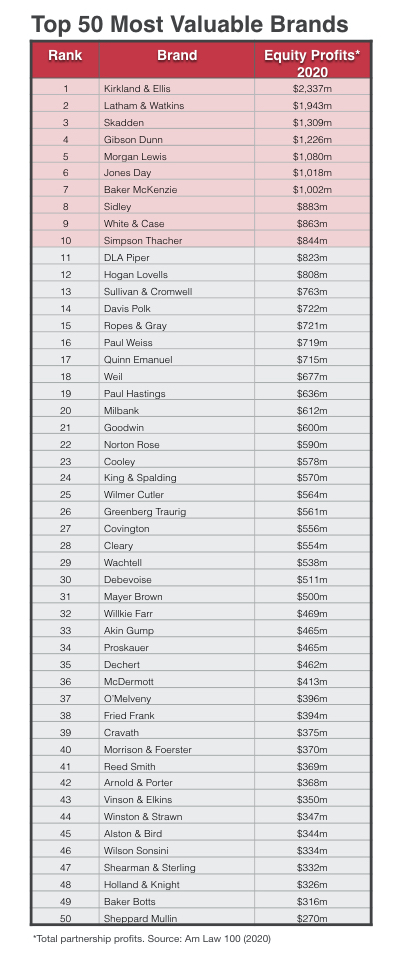World's Top 50 ‘US' Law Firm Brands 2020
A changed world
Our latest analysis of the Top 50 ‘US’ law firm brand rankings – gives a snapshot of how firms were performing before the virus-related disruptions took hold.
Nevertheless, the rankings still reveal some interesting insights into the way firms are encountering tailwinds or headwinds from the relative strengths and weaknesses of their brand and market positioning.
Next year’s data will show us how well these firms are able to weather the choppy economic waters to come, relative to their peers.
However looking at previous economic disruptions, the post-crisis data showed that firms entering the difficult period with the strongest brands were much more likely to emerge in better shape than those with weaker ones.
HIGHLIGHTS
- Kirkland & Ellis retains dominance as the world’s most valuable law firm brand.
- Latham adds the most absolute ($) value to its brand this year and closes gap on Kirkland.
- In relative (%) terms, McDermott has gained an amazing 31% in brand value in just one year.
- Holland & Knight also had a stellar year gaining 24% in brand value.
- Cleary and Quinn Emanuel falling fastest in both relative (%) and absolute ($) brand value.
- McDermott biggest riser in top 50 places.
- Cleary biggest faller in top 50 places.
- First 10 firms in the Top 50 are on average 2-3 times more profitable than last 10.
*Due to the different result publishing cycles, the largest UK-headquartered firms are not included in these rankings. Based on previous figures the four Magic Circle firms (Linklaters, Clifford Chance, Allen & Overy, and Freshfields) would feature in the top 10-15 along with Herbert Smith and Slaughter & May at around the top 40 mark. These firms will be included in September 2020, when we will publish our Global Top 50 rankings.
Solid at the top
Kirkland and Latham remain the world’s most valuable law firm brands closely followed by Skadden.
The Top 10 firms are the same names and are ranked in the same order as 2019 with only one place swap between Morgan Lewis (+1) and Jones Day (-1).
Whilst Kirkland continues to lead the rankings — a position the firm has held since 2017 — and continues to grow healthily at 8%, this year Latham has gained ground on them growing in brand value by 15%. The other very strong performance from a Top 10 firm came from Gibson Dunn who grew by 13% in the year.
As a group, these top 10 firms are 2-3 times more profitable than those ranking 40-50 – a stark demonstration of the power of a strong brand to drive performance among similar-sized firms, serving similar clients with similar capabilities.
Movement in the middle
Among the Top 20 most valuable law firm brands Fried Frank and Debevoise had strong years, gaining 16% and 15% in brand value respectively. Debevoise also rose another 5 places in the Top 50 building on a string of rises in recent years.
Other Top 20 firms advancing competitively were Hogan Lovells and Ropes & Gray, each climbing 3 Top 20 places in the rankings. Two firms knocking on the door of the Top 20, Goodwin and Cooley, each advanced 4 places to rank at 21 and 23 respectively.
Quinn Emanuel is the Top 20 firm that lost most brand value — losing 6% — and falling 6 places in the rankings. Just outside the Top 20, Cleary also had a tough year falling 7 places and losing 6% in brand value.
Further down the rankings, McDermott has had a stellar year, putting on an amazing 31% in brand value in just one year and rising 10 places in the Top 50 — from 46 to 36. Holland & Knight also had an impressive year gaining 24% in brand value. In place rises, Vinson & Elkins jumped up 4 places to reach 42 in the rankings.
—
Economics sidebar – why total partnership profits are a good measure of relative brand strength in Big Law.
Ranking the 50 most prestigious US-headquartered firms by their ‘global partnership profits’ gives a rigorous and substantive basis for assessing their relative brand value and strength over time.
The key to this insight lies in the underlying dynamics of the global law firm market which although quirky in many ways is, in economic-theory terms, a reasonably frictionless or ‘pure’ market (lots of competitors with relatively low market share, low barriers to entry/exit, similar products and excellent price visibility).
In other sectors profits can be heavily influenced by ownership of critical IP (pharma), regulations and licences that thwart competition (telecoms), assets that bar entry (energy), effective monopolies or oligopolies (big tech), etc. none of which applies in any significant way in the premium legal market.
Firms only succeed commercially over time if they compete effectively year in year out for what they earn and because the purchase cycle is relatively short clients can react quickly to any perceived changes in the relative competitiveness of any one firm.
Being a relatively ‘pure’ market, individual firms (and their partners) compete based on 3 components: reputation (what those who’ve experienced you think about your service), relevance (what problems you’re perceived to be best at solving and where geographically you solve them) and visibility (how well known you’re known to the clients around the world who have those problems – and the budgets to pay for your services).
These three components added together comprise a firm’s ‘brand’ – the combined brand equity of the firm and the partners within it (who also have brands of their own) – arguably the only source of sustainable competitive advantage that a law firm has.
It’s useful to point out that being a ‘stronger’ and more valuable brand overall does not necessarily imply being a ‘better’ brand for every occasion. For instance, the Mercedes brand is regularly measured to be approx. 10 times as valuable as the Ferrari brand in surveys ($50bn vs. $6bn).
—




